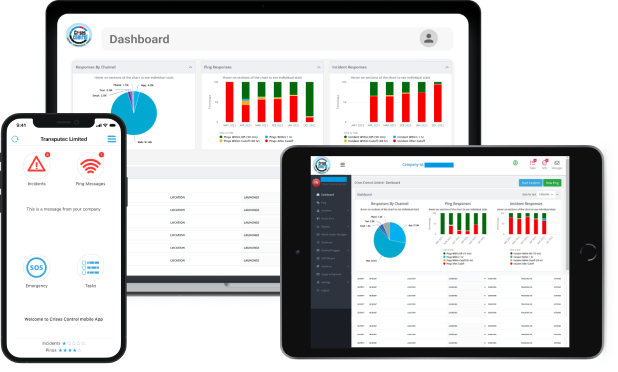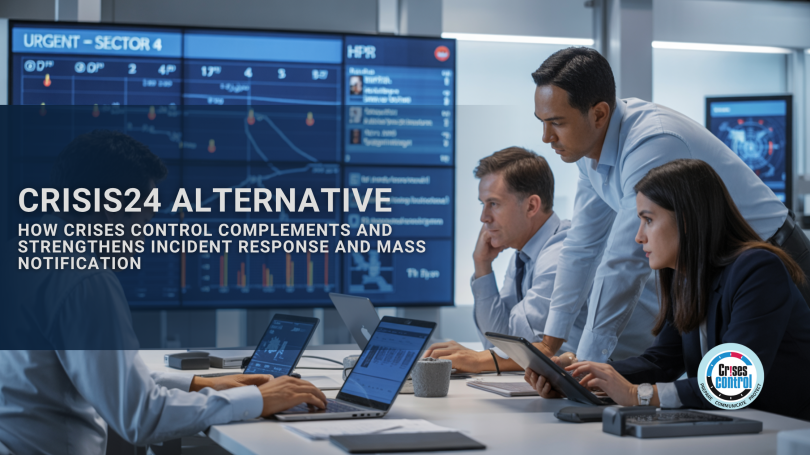When something goes wrong, whether it’s a cyber attack, power outage, flood, or even a system failure, knowing about it quickly is only part of the battle. What really matters is what happens next: how fast you act, how well you communicate, and how efficiently your team responds.
Many organisations turn to platforms like Crisis24 to stay ahead of threats. And with good reason. Crisis24 offers a powerful combination of risk intelligence, executive protection, and global security services. It can tell you when there’s unrest in a region, alert you to global travel risks, or track evolving situations through advanced intelligence tools.
But being informed is only one piece of the puzzle. When an incident directly affects your people, systems, or locations, you need more than monitoring. You need a way to respond immediately, communicate clearly, and manage the situation from start to finish.
Are you looking for a Crisis24 alternative? That’s where Crises Control comes in.
This blog explores how Crises Control compares with Crisis24, not to criticise, but to clarify the different strengths of each platform and explain how organisations can choose the right tool for incident response, mass notification, and business continuity.
Understanding the Difference: Risk Intelligence vs Operational Response
Crisis24 is widely known for its expertise in global threat intelligence. It brings together everything from geopolitical monitoring to medical evacuations, travel risk planning, and security operations consulting. It’s built to support organisations that operate across borders, manage high-risk personnel, or need real-time insight into external threats.
Part of its offer includes mass notification, using tools like TopoONE and OnSolve (formerly MIR3). These platforms support multi-channel alerting, two-way messaging, intelligent targeting, and real-time dashboards.
However, these capabilities are largely positioned within a broader risk management context. Mass notifications are integrated into a larger system focused on situational awareness and risk mitigation.
Crises Control, by contrast, is focused specifically on what happens inside your organisation when an incident occurs. It’s designed to support the full response cycle, not just alerting, but also task assignment, workflow automation, and real-time tracking of recovery efforts.
You can think of it like this:
- Crisis24 helps you understand what’s happening in the world.
- Crises Control helps you take action when that world affects your organisation.
What Crises Control Offers That Many Organisations Still Need
Even when a platform provides excellent risk monitoring, many organisations still struggle with:
- Reaching the right people fast during an emergency
- Triggering response plans that involve multiple teams
- Tracking actions in real time to avoid confusion or duplication
- Following up with post-incident reports and audits
These are the practical challenges Crises Control was built to address.
Mass Notification That’s Smart, Targeted, and Timely
Crises Control supports multi-channel alerting including SMS, voice calls, push notifications, email, web, and Microsoft Teams. You can create contact groups based on department, role, language, or location. There’s also geofencing support, so you can notify only those in a specific area, ideal for incidents like local outages, evacuations, or travel disruptions.
Unlike some mass notification tools, Crises Control builds in two-way communication, which means you can check who’s received the message, who’s safe, and who still needs help.
All notifications can be sent in multiple languages, ensuring clear communication even across global teams.
End-to-End Incident Management
While Crisis24 includes incident monitoring and high-level coordination features, Crises Control takes a more hands-on approach to internal incident response. Every incident logged in the platform can automatically trigger a response plan.
That might include:
- Assigning tasks to specific people or teams
- Notifying responders based on location or availability
- Escalating the issue if there’s no response
- Tracking progress in a live dashboard
- Auditing actions for compliance or review
Whether triggered manually or by a connected system (like a fire alarm or IT monitoring tool), incidents in Crises Control follow a structured path until resolution.
This means fewer delays, less confusion, and much more control in the middle of a stressful event.
Integration and Flexibility
Crisis24’s systems are deeply integrated with its risk intelligence tools. They’re valuable for global security operations, duty-of-care compliance, and threat monitoring.
Crises Control focuses instead on integration with everyday business tools: HR databases, Active Directory, Microsoft Teams, monitoring systems, and more. This enables faster onboarding and simpler adoption for internal teams.
You can deploy Crises Control in the cloud, customise workflows to suit your organisation, and set access rules for different roles. It supports single sign-on (SSO), open APIs, and modular configurations that grow with your needs.
Security, Compliance, and Data Control
Crises Control is built around the needs of organisations that handle sensitive data, work in regulated industries, or operate in environments where data sovereignty is non-negotiable.
Key compliance features include:
- ISO 27001 for information security
- ISO 22301 for business continuity
- Full GDPR compliance
- UK data hosting
- Role-based access controls
- End-to-end encryption
These features are essential in sectors like government, finance, healthcare, and critical infrastructure, where incidents must be handled with full traceability and control.
Who Should Use Which Platform?
Both Crisis24 and Crises Control offer strong capabilities, but they serve different purposes.
| Requirement | Best Fit |
| Global threat monitoring | Crisis24 |
| Travel risk planning | Crisis24 |
| Executive protection | Crisis24 |
| Internal incident management | Crises Control |
| Mass notification across your organisation | Crises Control |
| Coordinating response tasks | Crises Control |
| Compliance | Crises Control |
| Secure deployment | Crises Control |
Cost Transparency and Value
One of the challenges some organisations face with risk platforms is understanding what’s included and what might cost extra.
Crisis24’s pricing may vary depending on services selected, geographic coverage, and additional modules. It’s designed for complex, international risk environments where bespoke services are often needed.
Crises Control takes a different approach: transparent pricing with no hidden charges. The platform is modular, so you only pay for the features you need. As your organisation grows or your requirements change, Crises Control grows with you. It’s designed to be flexible and customisable, meaning you can tailor it to fit your structure, teams, and response processes. That makes budgeting simpler and ensures you’re only investing in the tools that deliver real value.
Final Thoughts: It’s Not Either/Or, It’s About Fit
Crisis24 is a respected platform, particularly for organisations that operate across borders, work with high-risk personnel, or need detailed risk intelligence.
Crises Control doesn’t try to replace that. Instead, it focuses on a different part of the process: what you do when something happens, not just when you hear about it.
If you already use a risk monitoring platform like Crisis24 but feel that your internal response could be sharper, or if you’re not yet managing incidents through a structured, centralised system, then Crises Control could be exactly what’s missing.
Want to See It in Action?
If you’d like to see how Crises Control supports internal response, mass communication, and operational resilience, we’d be happy to walk you through it.
Contact us to book a short, no-obligation demo and explore how it can fit into your existing risk and continuity planning.
Request a FREE Demo

